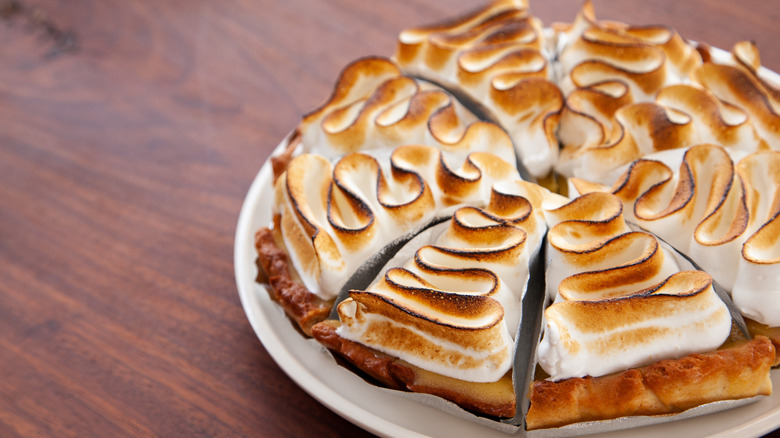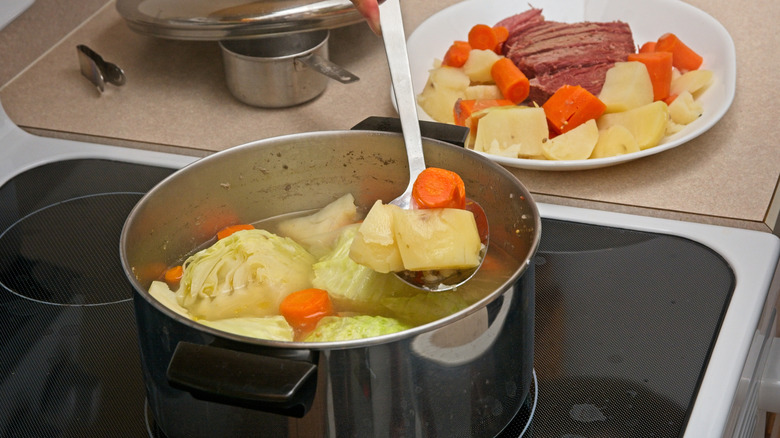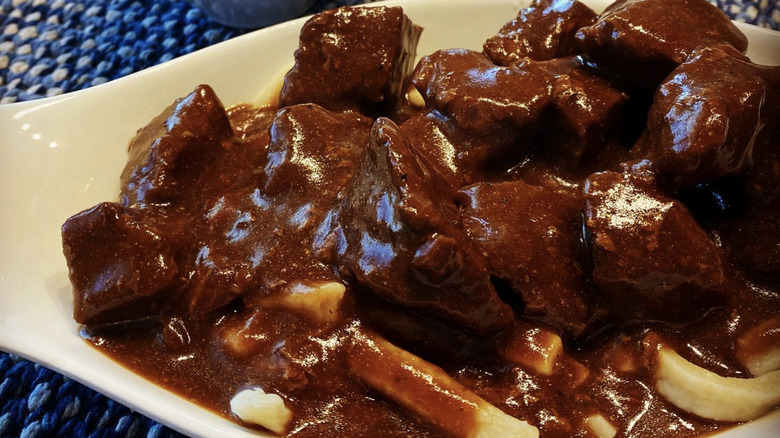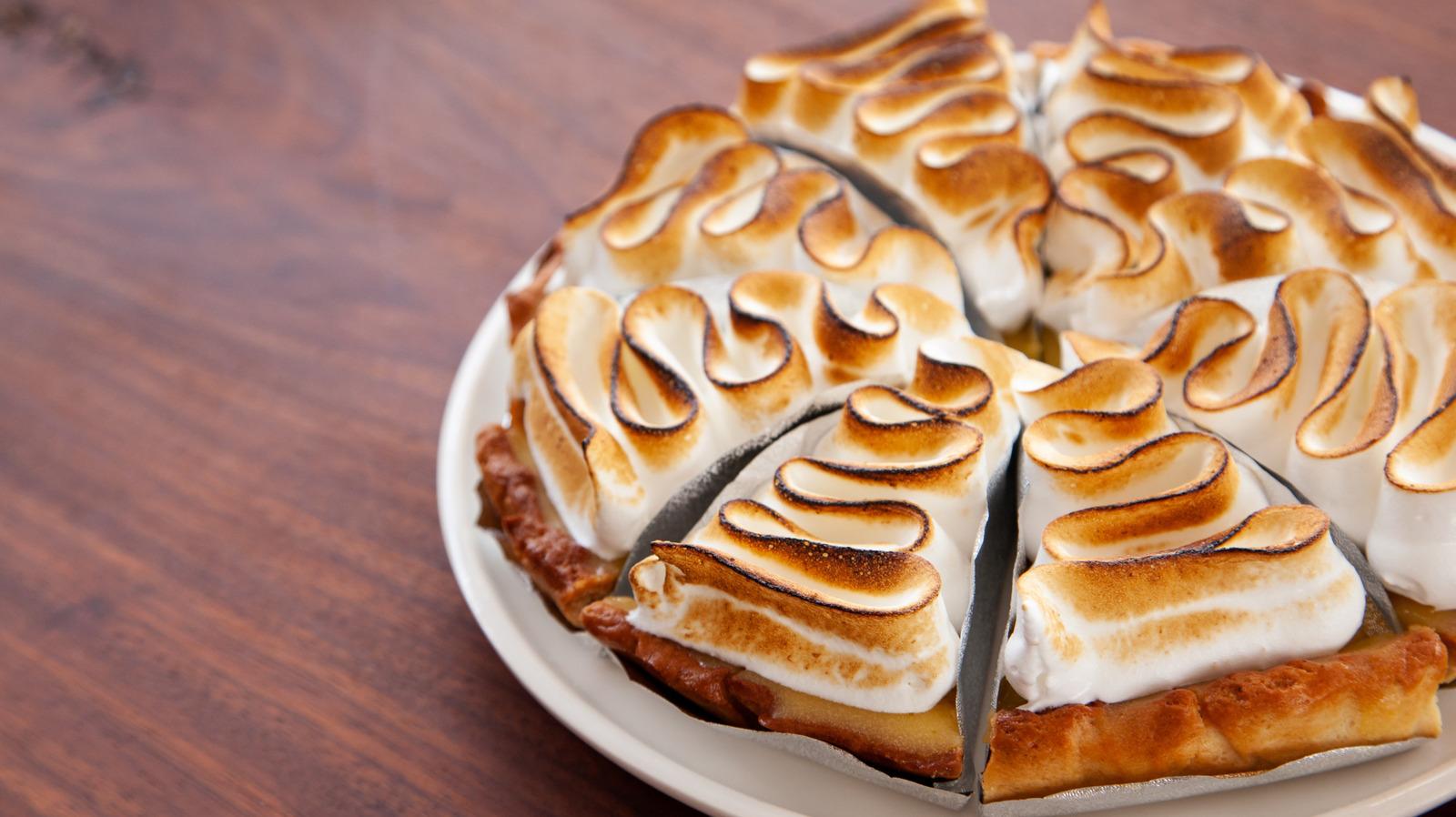
Kwanbenz/Shutterstock
We may receive a commission on purchases made from links.
What makes a state food classic? When learning about old-fashioned foods that have been forgotten from across all 50 states, one must quantify what makes a food regionally famous and then, how did it lose public recognition? First and foremost, truly regional foods rely on the ingredients that grow locally. With this in mind, it's impossible to ignore the history behind so many U.S. states before, during, and after colonization.
Many of the lost foods in the U.S. were prepared and eaten by people who had an unsung role in the kitchen over time. Indigenous communities, enslaved people, and women cooking for their families are responsible for creating a lot of the dishes on this list. Something else to consider is the evolution of popular culture. Certain cooking methods, ingredients, and flavors that were once in-demand have not translated to today's tastes. There are still people throughout the U.S. making an effort to keep classic state foods afloat in popular culture, but the ones on this list are on the verge of being forgotten.
Alabama: Turtleback cookies
The small Alabama town of Demopolis has a signature secret recipe. It's the turtleback cookie, a spiced yet sweet treat that time almost forgot. Traeger's Bakery was where turtlebacks, a golden cookie topped with a hard cinnamon frosting, were born. The original turtleback cookie recipe was lost in a fire in the '90s, a few years after Traeger's was sold. Since then, sentimental Alabamians have done their best to replicate it.
Alaska: Stink flipper
Indigenous communities in Alaska know all about old-school food preparation techniques, but fermenting stink flipper is becoming a lost art. Hunting sea mammals is prohibited by U.S. law, with exception to Alaskan natives. Groups like the Inuit waste nothing when harvesting seals and other sea mammals. Stink flipper is one example. The severed flippers stored in sacks are buried underground to ferment. Weeks later, they are exhumed and boiled for a delightfully pungent snack.
Arizona: Diné lamb shanks stew with green chiles
The Navajo People of Arizona, known as the Diné, made a unique lamb shank stew, sourced from Raza de Churra, or "Churros." The 16th-century sheep breed were brought to the Southwest by Basque explorers. Before colonialism decimated the Diné's crops, reduced their livestock, and systematically attacked their culture, Diné Lamb Shanks Stew with Green Chiles was a warming, classic dish enjoyed in Arizona.
Arkansas: Cherry nut pie
No-bake desserts are always in style, yet cherry nut pie, an old-time Arkansas favorite, got a little too classic. Roy Fisher's Steak House in Little Rock popularized this icebox pie, composed of cream-cheese filling, tart cherries, and toasty pecans inside a graham cracker crust. The restaurant opened in 1947 and was sold in 2005 when the Fishers retired. Under new ownership, locals said the cherry nut pie was never the same.
California: Acorn bread
Acorn bread has existed globally for centuries, and in California, it was first prepared by Indigenous communities throughout the state. Acorns were gathered for food in the late summer and autumn, roasted and shelled, then ground into flour. Acorn flour varieties with a high tannin content were soaked in water to leach toxins. The dough was cooked on hot stones, creating a dark, crusty bread that is dense, nutty, and largely forgotten.
Colorado: Mountain pie
Of all the regional pizza styles America offers, Colorado's mountain pie is one of the more obscure. Beau Jo's, a small pizzeria chain in the Mile High State, created mountain pie and is one of the only places keeping it alive. Mountain pie is characterized by a thick hand-rolled crust sweetened with honey. The pizza is designed to hold a lot of toppings and it does — the largest size weighs 5 pounds.
Connecticut: Shad roe
In early spring, those in the know head to the Connecticut River for a short but sweet shad season. Each year, shad migrate upstream through fresh coastal waterways to spawn. Shad roe, the egg sacs of female shad, have been eaten seasonally in Connecticut for hundreds of years. It's an unusual yet classic seafood dish, but fluctuations in shad migration numbers and a narrow fishing season now make shad roe an elusive delicacy.
Delaware: Delaware specials
"The Delaware Heritage Cookbook" printed in the 1980s, celebrated classic foods that "The First State" cultivated. An appetizer called Delaware specials was lost by time but feels relevant. The recipe calls for English muffins to be quartered and toasted then topped with mayo, sharp grated cheese, finely-chopped canned black olives, and green onions. Delaware specials have almost no online presence, but this lost recipe fits perfectly with the bachelorette eats and budget canapés of today.
Florida: Orange meringue pie
Of course oranges should be incorporated into pies as much as their citrusy siblings lemon and lime, and yet, Florida orange meringue pie is a relic. Recipe archivists in the Sunshine State credit the best-known recipe for Florida orange meringue pie to Caro Hare, an early 20th century socialite who loved to entertain. Florida orange meringue pie highlighted the best of Florida's bounty, but lacked the timelessness of other pies.
Georgia: Saraka
Deep within the recesses of Georgia's history is a rice cake that children called saraka. On Sapelo Island and St. Simons Island, enslaved people practiced their Muslim faith through charitable offerings called "sadaqa" or "saraka." Making small rice cakes (in the traditional West African style) and giving them to enslaved children was an act of saraka. The children later recounted being told to say "ameen" in prayerful praise before eating the rice cake.
Hawaii: Cream of luau soup
Potluck-style luau stew gets a lot of attention from recipe seekers looking for a taste of the islands, but cream of luau soup, a classic Hawaiian dish, was there the whole time. The thin-broth soup gets its body from coconut milk and lots of "luau" which translates to taro leaves. Vintage cream of luau soup recipes were passed onto other nations, like Japan, while simultaneously losing popularity in the states.
Idaho: Chokecherry pudding
The chokecherry pudding traditionally prepared by tribes from Idaho and Nevada was mostly forgotten until a high school student brought its medicinal benefits to light through a science project. "Toishabui", or, chokecherry pudding containing crushed seeds of the chokeberry plant were scientifically proven to reduce the size of uterine sarcoma cancer cells. This discovery gave much-needed recognition to the mindful diet Indigenous peoples of the U.S. have demonstrated for hundreds of years.
Illinois: Jim Shoe Sandwich
Chicago signature foods are aplenty, but even those well-versed in Windy City classics may not know the Jim Shoe Sandwich. The Jim Shoe — also spelled Gym Shoe or Jim Shoo — is a niche fixture of the South Side. Corned beef joins roast beef and shredded gyro meat in a submarine roll topped with onions, cheese, lettuce, tomato, giardiniera relish (or pickle), mustard, and gyro sauce. Napkins (and an appetite) are required.
Indiana: Persimmon pie
The vibrant and seasonal persimmon fruit is plentiful in the Midwest, inspiring locals past and present to make the most of them. Persimmon pudding remains relevant in Indiana, while persimmon pie has fallen under the radar. Home cooks who grew tired of regurgitated persimmon pudding recipes pivoted to pie. The inclusions of sour cream and brandy tamp down the persimmon's notorious bitterness, yet persimmon pie hasn't captured long-term attention for most Hoosiers.
Iowa: Mile high chiffon pie
Stone's Restaurant was famous in Marshalltown, Iowa, especially for Mile High chiffon pie. Stone's opened in 1887 and closed in the mid-2000s. Anna Stone, who married the founder's son, created Mile High chiffon pie, garnering attention from national magazines in the midcentury. During World War II, Stone's closed temporarily due to rations, but Duncan Hines himself wrote to Anna then, asking her to carry on. The dessert was his favorite.
Kansas: Chicken borscht
Mennonite communities that settled in Kansas brought traces of their Russian and Eastern European heritage with them. Chicken borscht is a dish that carries ancestral nomenclature and bears a distinctly American appearance. The beet-colored borscht of the Baltic region was reinterpreted by Midwestern Mennonites as a chicken-colored soup full of poultry-forward flavor. Chicken borscht is tough to come by today, yet its comforting properties rival any other soup out there.
Kentucky: Shuck beans
Appalachian foods haven't received enough acknowledgement in modern food culture, and shuck beans, aka shucky beans, aka leather britches, are one regional staple food that has fallen by the wayside. To conserve the harvest of long beans (predominantly green beans in Kentucky) crops were dried by being strung-up in windows and other arid locations. Rehydrating them often involved cooking them in animal fat, emitting a flavor that Kentuckians say tastes like home.
Louisiana: Tac-tac popcorn balls
A lesser-known Louisiana classic is boules de tac-tac, a popcorn ball with a rich history in New Orleans. Unlike the baseball-sized popcorn balls most Americans are used to, tac-tac are something you could clutch in your fist. Early tac-tac recipes aren't spherical at all, resembling something more like peanut brittle. What separates tac-tac from your average popcorn ball is nuts. Authentic tac-tac also forgoes the marshmallow and candies popular in popcorn balls today.
Maine: Boiled dinner

John Blottman/Shutterstock
It's a wonder that the boiled dinner once popular in Maine ever made it across the pond from Ireland where its creators came from. What was collectively known as "New England boiled dinner" in Maine was basically a St. Patrick's stovetop boil served any night of the week. A pot of salted water containing corned beef, peeled potatoes, celery, carrots, cabbage, parsnips, and/or turnips is a formerly-enjoyed food modern diners haven't prioritized.
Maryland: Fish pepper
For most of the 20th century, people forgot about the fish pepper. Historians believe that Caribbean natives, possibly from Haiti, brought firm-skinned, spicy fish peppers to Baltimore in the 1800s where they enjoyed fleeting popularity amongst the era's Black gardeners and cooks. In 1995, fish pepper seeds were found in the freezer of beekeeper H. Ralph Weaver (he received them from African American painter Horace Pippin), and the near-extinct fish pepper was restored.
Massachusetts: Spider cake
New England spider cake is a yesteryear classic. This sweetened, milk-soaked cornmeal cake cooked over a fire, showcased flavors and techniques colonists learned from Indigenous peoples in early settlements like Plymouth Rock. A spider cake recipe appeared in "The American Frugal Housewife" cookbook, printed in Massachusetts in 1828. Some say the term "spider cake" referred to the legs of the cast iron Dutch oven the cake was often prepared in.
Michigan: Muskrat dinner
Muskrat dinner isn't heralded as one of Michigan's signature state foods, and it would probably have been forgotten if not for a small group of residents keeping the tradition alive. The muskrat is a wetland rodent that weighs about 4 pounds. Eating muskrat during Lent caught on in the Detroit metro area in the 1800s, particularly with the region's French-Canadian population. Some churches still host these wild game dinners, where muskrat and sides offer a taste of the past.
Minnesota: Lutefisk
From the 1850s to the 1930s, an influx of Scandinavians from Denmark, Norway, and Sweden settled in Minnesota and brought a strong cultural influence. Lutefisk is one example. This classic lye-soaked white fish isn't a huge hit with everyone. Soaking dried fish in lye is a centuries-old method of rehydrating fish (usually cod), but also gives it a gelatinous texture. Although the lye is rinsed off prior to cooking, this outdated practice isn't appetizing in the 21st century.
Mississippi: Buffalo fish ribs
In Mississippi, knowing how to prepare buffalo fish is becoming less common, but for those with the skill, eating buffalo ribs is a true soul food treat. The freshwater fish is very bony, but cutting it into "ribs" makes it easier to eat around them. Old-school buffalo fish ribs are typically coated with a seasoned cornmeal breading and fried in oil. The delicate meat is often compared to catfish.
Missouri: Kettle beef

jeftink06 / Instagram
Some of the heartiest foods are conceptualized out of necessity, and Missouri's kettle beef is one of those dishes. Rump roast, a cheap yet plentiful cut, inspired home cooks from the Show-Me state to create kettle beef, a slow-roasted, potted meal cooked with bacon drippings and herbs and accompanied by brown gravy and handmade dumplings or thick pasta noodles. Kettle beef had commercial potential, but got lost in a sea of slow cooker recipes.
Montana: Pasties
Fans of "The Great British Baking Show" are likely familiar with Cornish pasties, but their status as a Montana classic is a bit outdated. In the late 1800s, enterprising Brits migrated to Butte, Montana to mine copper. Many of these miners, from Cornwall, brought the taste of home with them. Cornish pasties were a perfect lunch for the hardworking miner: filling and handheld. Mining is no longer a booming industry in Montana, and the pasties associated with it have dwindled as well.
Nebraska: Frosty ice cream
The small town of Benkelman, Nebraska is home to a malted chocolate "Frosty" ice cream that may or may not have inspired the legendary Wendy's confection. Pharmacist and drugstore owner Evan "Bud" Moses came up with the recipe in the 1940s, and it's still offered at Benkelman's Dundy County History Museum. The vintage soda fountain recipe remains top-secret, and with such little exposure, most Americans are unaware of its existence.
Nevada: Pine nut cakes
Pinon or piñon is a known term in Nevada for "pine nut." Pine nut cakes were once common there, but they are now harder to come by. Indigenous peoples of the Great Basin perfected the labor-intensive art of harvesting pine nuts and grinding much of what they harvested into flour. Pine nut cakes resemble many of the Indigenous fry breads still eaten today, but showcase pine nuts in a way worth remembering.
New Hampshire: American chop suey

Douglas324/Getty Images
American chop suey's waning prominence in states like New Hampshire reminds us of how simple dinners have evolved over time. The dish's name is borrowed from Chinese-American chop suey, and its contents represent the humble comfort dinners older New Englanders know well.
Elbow macaroni dances with stewed tomatoes, ground beef, and cubed bell pepper to become American chop suey. In New Hampshire, it's a reminder of the hearty home-cooked dinners that affordably fed big families.
New Jersey: Health salad
Some know it as Claremont salad, others as health salad. No matter the name, this coleslaw-esque dish currently exists in the back pages of New Jersey's signature foods. The salad, made up of shredded cabbage, carrots, radish, and vinegar, has Jewish deli roots, but got noticed at the now-defunct Weequahic Diner in Newark and Claremont Diner in Verona. Today, it's rare to see health salad on the table at all.
New Mexico: Chaquewe
New Mexico offers a rich history of classic foods, but some have fallen off the radar. Chaquewe is a prime example. If New Mexico's food has a love language, it's written in blue corn. "Chaquehue", or chaquewe, is the Puebloan word for "porridge," a cornerstone of the Indigenous diet. For many New Mexico natives, chaquewe is vital morning oatmeal, yet its sheer simplicity may be part of why this true American food is overlooked.
New York: Nesselrode pie
In the 1940s, Nesselrode pie was the trendiest dessert of the Big Apple. Nesselrode pie, named after Victorian-era frozen puddings, featured fluffy gelatin, puréed or glacéed chestnuts, rum or brandy, and candied cherries — all of which felt very contemporary to mid-century tastes. Hortense Spier, an Upper West Side restaurateur, is credited with originating the recipe. When New York City restaurants began creating knock-off Nesselrodes, Spier's pie fell out of style.
North Carolina: Yellow jacket soup
Forgotten recipes like yellow jacket soup, demonstrate the immense resourcefulness and creativity of Native American cooking. In North Carolina, a Cherokee recipe for wasp soup from the 19th century was recreated at Heirloom, a restaurant turned catering service that specialized in foraged fare. The Cherokee peoples of Appalachia were adventurous eaters, however, yellow jacket soup, which involves roasting the nest's combs and the wasps inside, was reserved for situations when other foods were scarce.
North Dakota: Ammonia cookies
Today, the word "ammonia" has no place in the kitchen except to clean it. That's because we have baking powder now. Baking ammonia was once a necessary ingredient to leaven cookies. In states like North Dakota, ammonia cookies were a classic sweet with a light, cakey texture. Baking ammonia had the same caustic smell we associate with the cleaning agent today, however, the odor completely dissipated in the oven.
Ohio: Johnny-in-the-bag sausage
Blood sausage is a historically tough sell with Americans, and the scarcity of Johnny-in-the-bag sausage from Ohio reflects shifting tastes. For over 100 years, Stehlin's Meats of Greater Cincinnati crafted a German blood sausage locals called Johnny-in-the-bag. Beutelwurst, or "bagged sausage," is pork blood sausage that is dried in sacks and made with rye meal. Sizable speckles of bacon fat give Johnny-in-the-bag its trademark look.
Oklahoma: Sofkee
Oklahomans usually cook sofkee when they know elders are around, and this is perhaps why the dish hasn't had long-term staying power. Sofkee is a sour corn mush that's part drink, part porridge, prepared in the traditional fashion of Oklahoma's tribes, including Creek, Cherokee, Chickasaw, Choctaw, Muskogee, and Seminole. To make sofkee, white cracked corn is cooked in salted water, with the only additive being lye ash. The lack of seasoning makes sofkee an acquired taste.
Oregon: Shrimp melt
Oregon pink shrimp is a regional crustacean and the shrimp melt is an Oregon classic, though its relevance in a state known for its quirky food scene has ebbed. Oregon pink shrimp are smaller and sweeter than other varieties, which allows them to be mixed with mustard, mayonnaise, and spices while remaining intact. The shrimp melt is topped with broiled cheese and served open-faced, though fewer Oregon restaurants are serving it today.
Pennsylvania: Buweschenkel (aka boova shenkel)
Pennsylvania Dutch cuisine has given Americans many recipes, but dishes like buweschenkel, or, boova shenkel don't get much attention. Boova shenkel are large dumplings that resemble pierogis. Inside, you'll usually find Pennsylvania Dutch potato filling (a mixture of potatoes, onion, celery, herbs, and breadcrumbs), but meat is sometimes added. Some longstanding restaurants that served boova shenkel have closed or modernized the menu.
Rhode Island: Uppaquontup
Most Americans have shunned the practice of eating fish heads, but Indigenous Rhode Islanders thought otherwise. Before Western influence got in the way, Algonquin-speaking tribes like the Narragansett feasted on boiled fish heads, or, uppaquontup, Algonquin for "head."
Bass was a common type of uppaquontup eaten in Rhode Island. The Narragansett nation declined during the 17th century due to the rising colonist population, yet their traditions were observed and documented.
South Carolina: Carolina rice-stuffed fish
The Gullah community of South Carolina's sea islands, know about foods most have forgotten. Carolina rice-stuffed fish is a true delicacy, and a rare one. Those that cook the recipe well are mostly elderly.
Rice is paramount in Gullah cuisine. Jollof rice, a West African staple, inspires many dishes eaten in Low Country. Carolina rice-stuffed fish utilizes seasonal catches, calls for half of a hollowed-out apple to be placed in the fish's head, and reminds us how special old recipes can be.
South Dakota: Pheasant sandwich
During World War II, Aberdeen, South Dakota became famous for pheasant sandwiches when a group of mostly female volunteers set up the Pheasant Canteen at the local train depot. Pheasant sandwiches provided nuanced relief to American soldiers passing through Aberdeen by train. Farmers supplied the pheasants and the hardworking crew prepared enough pheasant salad (similar in format to chicken salad) to feed every serviceman free of charge — sometimes up to 1,500 people a day.
Tennessee: Doodle soup
Bradford, Tennessee is the Doodle Soup capital of the world. Yet with a population of roughly 985 people, its signature dish has mostly been forgotten.
But don't sleep on Doodle soup. The vinegary, spiced broth bolstered by slow-cooked chicken and all the drippings is basically the hot and sour soup of the South. Historians claim Doodle soup's origins stretch back to the Civil War. The bigger debate involves the appropriate side: some say crackers, others swear by a biscuit.
Texas: Picnic stew
This Lone Star outdoor favorite, also known as Czech-Tex picnic stew, resonates with fewer residents these days. When Czechs tried and failed to revolutionize their political system in the mid-1800s, many set off for Texas to quench the freedom of frontier life.
Places like Shiner, Texas retain the culinary traditions of its Eastern European forebears through picnic stew, a beefy, red-brothed dish full of potatoes and other assorted veggies that (surprise, surprise) is a hit at picnics.
Utah: Southwest peaches
Georgia peaches are an American must-have, while Southwest peaches have struggled to exist. Utah is looking to change that. The Navajo community has located the few Southwest peach plants (called "Diné didzétsoh" in Navajo) and is working to revive the once-thriving crop that was intentionally destroyed by the government in the 1860s. Southwest peaches are less sweet than the Georgia variety and carry flavor notes of melon or cinnamon.
Vermont: Roasted skunk
If you're wondering why anyone would eat roasted skunk, you're not alone. For Indigenous communities of Vermont, like the Abenaki, it was one of the many game meats that made it to the table, but even some modern Abenaki members have revealed they aren't enthusiastic about trying it. The key to enjoying roasted skunk meat (which is allegedly sweet and light) is through skinning and cleaning of the meat and of course, removing the scent gland.
Virginia: Panfried quail with country ham
The legacy of cookbook author and Virginia chef Edna Lewis was overlooked for too long. Lewis' recipes, including pan-fried quail with country ham were nearly forgotten, but thanks to African American chefs seeking to revive Lewis' culinary intuitions, these classic foods are getting more love. Lewis individualized her quail recipe by cooking the foul in brown butter and fresh grape juice. These flavors may seem unusual, but Lewis was always purposeful with her ingredients.
Washington: Slow-roasted camas
Time and time again, U.S. Indigenous communities remind us of native plants most Americans have forgotten about. In Washington, camas is one such plant. The bluish-purple flowers of camas plants might make one assume this wild onion isn't worth eating. Indigenous peoples of the Northwest have proven otherwise.
Camas bulbs require slow-roasting. After 24 to 48 hours, the bulbs become sweet. Ground camas bulbs are used in savory dishes like meatballs or salsa or in sweets like ice cream.
West Virginia: Cottage cheese soup
West Virginians of a certain era remember the cottage cheese soup served at The Red Fox Inn at Snowshoe Mountain, but the internet has left this quirky soup behind. We've heard about cottage cheese used to thicken soups and add protein, but cottage cheese as a soup flavor star? Surely not. After The Red Fox Inn closed in 2006, this regional cult classic was mostly relegated to memory.
Wisconsin: Red Dot potato chips
Wisconsin residents who grew up in the '40s and '50s probably remember Red Dot potato chips, a Madison-based snack created by Frederick J. Meyer in 1938. Along with potato chips, Red Dot sold popcorn, pretzels, and other snacks.
Red Dot was such a trendsetter, that future chip icon Lay & Company proposed a merger. Meyer agreed, but allegedly regretted relinquishing sole-ownership of the brand.
Wyoming: Ya ha
The term "ya ha" is probably as unfamiliar to you as the thought of eating a yellow-bellied marmot — which is exactly what ya ha means. In Wyoming, the Eastern Shoshone were known to enjoy ya ha.
The Shoshone still occupy the Great Basin, which touches part of Wyoming. When they're not hibernating, ya ha notoriously stretch out on the rocks after a big meal, making them convenient prey for Shoshone people.



